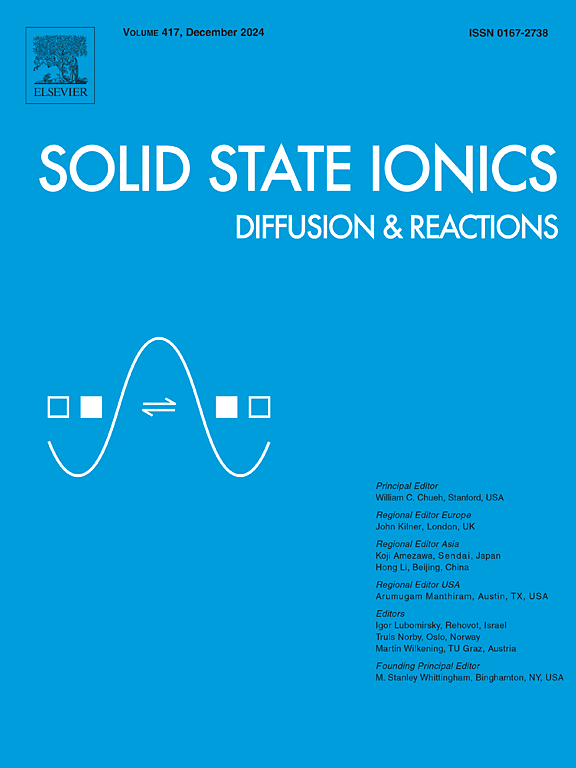Construction organic composite gel polymer electrolyte for stable solid-state lithium metal batteries
IF 3
4区 材料科学
Q3 CHEMISTRY, PHYSICAL
引用次数: 0
Abstract
Gel polymer electrolytes (GPEs) synergizing the advantages of both solid and liquid electrolytes are promising electrolyte candidates for lithium metal batteries (LMBs). However, due to the presence of the liquid medium, mechanical performance and thermal stability are compromised. To address this issue, we designed and prepared an organic composite GPEs by immersing a PVDF-HFP fiber membrane in a polyIL-in-salt ionic solution. This process imparts exceptional high-temperature stability (decomposition temperature of 340 °C) and enhanced mechanical performance (Young's modulus of about 6.7 MPa) to the GPEs. The incorporation of polyIL-in-salt ionic solutions is found to enhance the ionic conductivity of GPEs to 0.69 mS cm−1 at 25 °C, facilitating a homogeneous distribution and accelerating ionic migration. The Li||Li battery utilizing this electrolyte effectively alleviates the concentration polarization and achieves the stable cycle performance over 1200 h at 0.25 mA cm−2 at 50 °C. Additionally, the lithium metal battery, which incorporates the organic composite gel polymer electrolytes, has exhibited an extraordinary specific capacity of 167.3 mAh g−1, accompanied by a retention rate of 99.1 % at 50 °C, even after 100 cycles. This study asserts that the innovative organic composite GPEs exhibit considerable potential for practical applications in lithium metal batteries (LMBs).
构建稳定固态锂金属电池用有机复合凝胶聚合物电解质
凝胶聚合物电解质(GPE)协同了固态和液态电解质的优点,是锂金属电池(LMB)的理想电解质。然而,由于液态介质的存在,其机械性能和热稳定性会受到影响。为了解决这个问题,我们设计并制备了一种有机复合 GPEs,方法是将 PVDF-HFP 纤维膜浸入盐离子溶液中的 polyIL 中。这一工艺赋予了 GPE 超强的高温稳定性(分解温度为 340 °C)和更高的机械性能(杨氏模量约为 6.7 兆帕)。在盐离子溶液中加入 polyIL 可将 GPE 的离子电导率提高到 25 °C 时的 0.69 mS cm-1,从而促进均匀分布并加速离子迁移。使用这种电解质的锂电池可有效缓解浓度极化,并在 50 °C 条件下以 0.25 mA cm-2 实现 1200 小时以上的稳定循环性能。此外,结合了有机复合凝胶聚合物电解质的金属锂电池显示出了 167.3 mAh g-1 的超凡比容量,即使在 50 °C 下循环 100 次后,保持率仍高达 99.1%。这项研究表明,创新的有机复合凝胶聚合物电解质在锂金属电池(LMB)的实际应用中具有相当大的潜力。
本文章由计算机程序翻译,如有差异,请以英文原文为准。
求助全文
约1分钟内获得全文
求助全文
来源期刊

Solid State Ionics
物理-物理:凝聚态物理
CiteScore
6.10
自引率
3.10%
发文量
152
审稿时长
58 days
期刊介绍:
This interdisciplinary journal is devoted to the physics, chemistry and materials science of diffusion, mass transport, and reactivity of solids. The major part of each issue is devoted to articles on:
(i) physics and chemistry of defects in solids;
(ii) reactions in and on solids, e.g. intercalation, corrosion, oxidation, sintering;
(iii) ion transport measurements, mechanisms and theory;
(iv) solid state electrochemistry;
(v) ionically-electronically mixed conducting solids.
Related technological applications are also included, provided their characteristics are interpreted in terms of the basic solid state properties.
Review papers and relevant symposium proceedings are welcome.
 求助内容:
求助内容: 应助结果提醒方式:
应助结果提醒方式:


